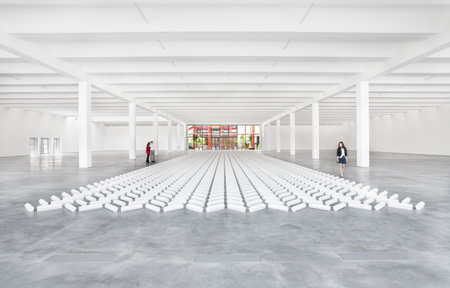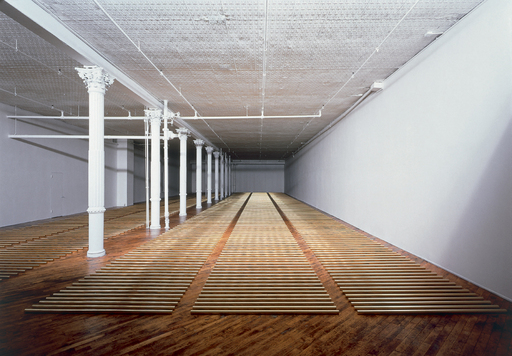In 1969, when Lee Lozano began her Dialogue Piece, a project for which she simply invited artists and others to talk with her, she called Walter De Maria twice, once on May 11 and once on May 13. On June 18, she sent him a postcard:
The reason I called you twice to which you have not been gracious enough to reply was to invite you for a dialogue. Love, Lozano. [Walter replies by letter before he leaves town for summer. July.]
She never did catch him. When Thomas Kellein wrote about De Maria’s Broken Kilometer for Tate Etc., he described the difficulty he’d had in meeting De Maria. Kellein unsuccessfully requested an interview during Documenta 6 in Kassel in 1977. He recalls, “[De Maria] explained to me at length – in a telephone call lasting around 40 minutes – that he was unfortunately not able to meet my request.” Soon after, Kellein flew to New York, struggled again to arrange an interview with the artist and then luckily ran into him at the Dia Art Foundation in SoHo. Three days later, the two men were together in a cafe, only the conversation did not go as planned. Writes Kellein,
I had a whole sheaf of questions with me. But there seemed to be no chance of talking about art. And in the weeks, even years, to come, whenever De Maria and I met, in the friendliest of circumstances, the conversation never turned to his works. They were to remain a mystery, and De Maria didn’t even want to talk about that.
That an artist whose work has always been theatrically sprawling would have a Jasper Johns-like penchant for privacy seems incongruous, but also makes the aloofness of his exhibitions all the more intriguing.
Last month, the Los Angeles County Museum of Art (LACMA) announced a one day-only showing of a De Maria installation inside the Resnick Pavilion, the museum’s freshly constructed, soon-to-open building. This showing would, according to LACMA Director Michael Govan, allow the museum to “test the Resnick Pavilion’s capacity to deal with large-scale work,” though “test” may be a stand-in for “show off.” The prestige of the “one day only” designation slipped slightly as the museum announced subsequent day-only showings, but the elusiveness of the whole endeavor still matches the elusiveness I’ve come to associate with De Maria.
The 2000 Sculpture consists of 2000 geometrically pristine white rods that span the length of the gaping pavilion. They are calm and aloof and — it’s true — the Resnick houses them beautifully; viewers have plenty of room to meander but the space feels full. I saw The 2000 Sculpture at dusk on June 17. The inside of the Resnick was darkening along with the rest of the outside world, and this softened the coolness of the gridded rods in favor of their calmness. I’d met a friend whom I hadn’t seen in months at the ticket counter and the two of us were already lost in conversation by the time we entered the pavilion. We walked the circumference of De Maria’s piece maybe two or three times, and then stopped for a while along its right edge, still talking about our own lives. She’d recently returned from a wedding in Ecuador, for which she’d had to undertake strange and stressful tasks, like driving around unfamiliar villages in search of the cheapest roses and trying to bridge cultural gaps between the bride’s East Coast parents and the groom’s Ecuadorian family. I had stories to tell too, about friendships gone wrong, adventures in tow trucks, and upcoming vacations.
When we finally wandered out, my friend said, “I’ve always had a spot in my heart for De Maria.”
“I enjoyed that,” I said, and meant it. But like De Maria, we didn’t want to talk about art.






Pingback: Infinite Donald Judd, the CalArts MFA Show, etc. [Collected] | 16 Miles of String: Andrew Russeth on Contemporary Art and Art History | ARTINFO.com
Pingback: - Brain Store